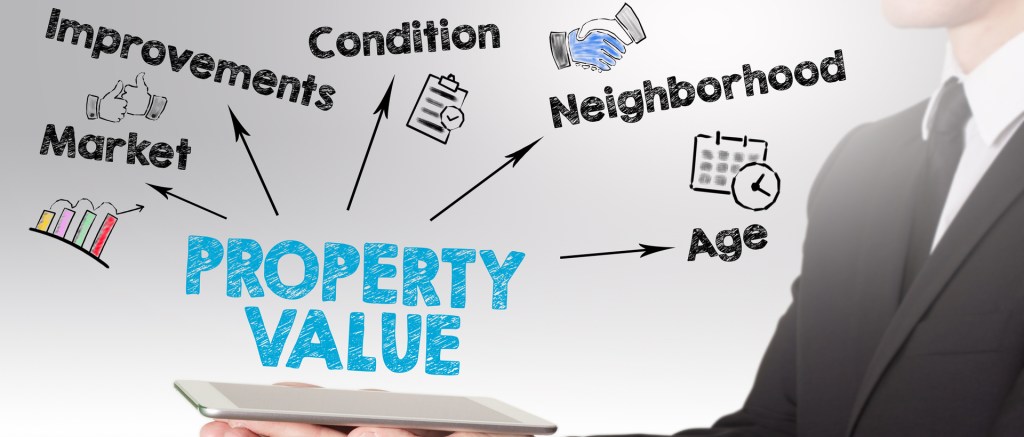
How to Determine the Fair Market Value of Commercial Property

When entering the commercial real estate market, few things are as important as knowing how to determine the fair market value of commercial property — whether you’re looking to buy, sell or even just enter a lease. Knowing a commercial property’s value is essential for successful investments and business dealings. But it’s also equally as important in determining whether the price of a property is reasonable in an open and competitive market in which all parties involved approach the deal fairly and with all necessary information at hand.
There are multiple approaches in how to determine the fair market value of commercial property, and each has its own advantages and disadvantages depending on your investment, financial and development goals. And the method that works best can also be tied to personal preference, familiarity with certain methods or industry-specific standards — such as the cost per unit approach, which is primarily used for apartment buildings.
Explore the many approaches to determining the fair market value of commercial properties and see which method best suits your business needs.
1. Income Approach (Income Capitalization Approach)
The income capitalization approach is one of the most popular valuation methods in commercial real estate transactions since it determines a commercial property’s fair market value in relation to the income it can generate under the market conditions that exist at the moment of valuation.
Specifically, this method establishes the property’s net operating income (NOI) by considering a property’s expenses (utilities, staff, maintenance, etc.) and its effective gross income (income generated under current market conditions and occupancy or use rates). Then, the NOI is divided by the current cap rate, resulting in the fair market value of the property.
However, sometimes, a commercial property’s NOI cannot be determined. This may be the case if the property has been vacant for a while or if investors are looking for more nuanced results. In this situation, the NOIs of comparable properties will be calculated to use as projections. Then, if a CRE investor plans to upgrade the property and lease it at a higher price, the NOI will take projected earnings into account. Similarly, if the buyer has identified opportunities to lower operating expenses, the NOI will reflect that in the income approach, as well.
The capitalization rate (cap rate) is determined by a variety of factors, including the cap rate of comparable properties in the area; the building’s age; state of repairs; tenant roster; architectural and technological features; location; class; sales price; and more. The cap rate can also be determined by dividing the property’s sales price (or listing price) by its NOI. Note that if an accurate cap rate cannot be established for a property, a market cap rate can be determined using comparable properties in the area.
2. Replacement Cost Approach (Cost Approach)
When determining the fair market value of commercial real estate, the cost approach uses the current value of the land that the property sits on, as well as the cost of rebuilding the entire property at the time of the valuation, and then deducts the depreciated value of the existing structure. Additionally, the most central characteristic of the replacement cost approach is that it considers the most efficient and profitable use of the property. Of course, this can also be a disadvantage in places where zoning laws will interfere with that use.
The primary advantage of the cost approach is that it uses the current value and conditions, which make this valuation method common practice among tax assessors, as well as lenders financing multi-phase developments. It’s also commonly used to establish a commercial property’s value for insurance purposes or determine the market value of a commercial property when there are insufficient comparable properties in the area for an accurate estimate (whether that’s a result of a highly customized structure or a question of location).
Often, the replacement approach is used in tandem with the sales comparables approach to help investors determine whether to buy a property or build a new one. Generally, investors will avoid projects in which the purchase and improvement costs surpass the valuation determined through the cost approach. As such, herein lies one of the most important disadvantages of the replacement cost approach: It doesn’t include any income that the property might generate if used as an income-producing property.
3. Sales Comparables Approach (Market Value Approach)
Considered by some to be the most straightforward way to determine the fair market value of commercial property, the sales comparables approach relies on recent area sales and/or listings of similar commercial properties. As part of this method, a value range is initially established with comparables. Then, a more accurate figure is determined by adjusting for the property’s age; state of repairs; upgrades or additions; land-to-building ratio; location and area tax rates; the size of the land; and more — all of which are considered in relation to current market trends.
However, one major disadvantage of this method is that it doesn’t take into account potential repair or maintenance costs, building expenses, or occupancy rates. This approach is also sensitive to market activity. For example, if area comps are too old, they won’t provide a fair range in line with current market conditions.
Fortunately, in today’s increasingly technology-driven environment, brokers can simplify their comps and increase the accuracy of their findings with online platforms built on comprehensive commercial real estate data that also offer agile, broker-oriented tools, including commercial comparables or local market insights based on the most recent area sales for the most accurate commercial property values.
Finally, the comparables approach is often used in tandem with the replacement cost approach to determine whether a buyer should purchase a property or build a similar, new one. It’s also a popular approach for buildings that are mostly empty or have an extremely low tenant footprint, in which case the existing or potential income has little to no influence on the market value determined through the sales comps method.
4. Discounted Cash Flow Approach (DCF Approach)
While the income, sales and replacement methods are solid approaches to determining the fair market value of commercial properties at a particular point in time, one of the major disadvantages of all three of these is that they don’t consider changing values and market trends over time. Likewise, they also don’t take into account the equity resulting from the sale of a property at the end of the holding period of an asset, which is a major source of income within the lifecycle of a deal.
Conversely, the discounted cash flow (DCF) approach takes into account the projected difference between the potential owner’s purchase price and the estimated sale price at the end of the holding period; the time value of money (including inflation, risk, reinvestment potential, net present value and internal rate of return) and the net cashflow; tenants and lease terms; staff; and management. Real estate market fundamentals and trends are also considered here, including occupancy levels; rent rate and rent rate trends; new supply; and absorption of similar properties in the area.
Financing fundamentals too are important elements of this valuation method, as commercial real estate deals often involve some type of debt financing (most likely a senior loan, potentially also a mezzanine debt).
5. Gross Rent Multiplier Approach (GRM Approach)
The gross rent multiplier (GRM) approach determines commercial property values similar to the income approach but uses gross rent instead of a property’s NOI — thus discounting expenses like maintenance, staff wages, taxes and so on. Consequently, this disregard for operating costs represents its most significant disadvantage and is the reason why the GRM approach is used in conjunction with other methods of calculating fair market value for commercial properties.
The other major difference between the GRM approach and the income approach is the gross rent multiplier, a figure that replaces the traditional cap rate. If the property doesn’t already have a gross rent multiplier determined, then the gross rent multiplier of comparable properties in the area is determined.
The GRM approach is one of the easiest methods to determine fair market values for commercial properties, as well as to project the potential income of an investment property in relation to its value. That said, the other major disadvantage (in addition to not taking operating expenses into account), is the potential difficulty of finding enough relevant comparable assets in the area to determine a market gross rent multiplier.
6. Price Per Square Foot Approach (Price Per Unit/ Price Per Key Approach)
Although usually not used on its own to determine the market value of commercial real estate (like the income capitalization approach or the sales comparables method), the price per square foot method is, nevertheless, a quick way to consider or discard a potential investment opportunity before investing more resources into examining its viability.
The price per square foot approach encompasses three subtypes:
- The pure price per square foot approach: Most often used for office, industrial and retail properties, this approach determines a commercial property’s value by multiplying the property’s square footage with a pre-determined price per square foot.
- The price per unit approach: Primarily used for apartments and condominiums, this method delivers the value of a commercial property by multiplying the price per unit by the number of units.
- The price per key approach: Used in the hospitality industry, this approach determines the market value of commercial properties by multiplying the price per key by the number of guest rooms.
In all three approaches, if a price per square foot, unit or key is not readily available, a range can be determined based on those of comparable properties in the area. In this situation, the target property’s price per square foot would then be adjusted for its specifics, such as age, state of repairs, location and more.
While the price per square foot can be used to quickly identify a theoretical valuation threshold, it can also be implemented as part of the gross rent multiplier and discounted cash flow methods. It’s also often employed in the development or renovation phase of a commercial property, as it provides a quick overview of overall costs and how upgrades or downgrades affect the value and cost of development, redevelopment or renovations.
7. Determining the Right Approach for You
When it comes to how to determine the fair market value of commercial property, usually more than one method is used to home in on the finest of details that might impact a CRE deal. Whether you start off with back-of-the-napkin calculations or research potential values through online algorithms, before pen touches paper, investors and brokers alike should always run their own due diligence with at least two different valuation approaches that complement each other, taking into account as many variables as possible.
More Articles You Might Like
Anticipated Office Distress to Materialize in 2025
The wave of distress anticipated since the peak of the pandemic has begun to materialize at the beginning of 2025.
What’s New in CommercialEdge This Quarter
The latest product updates focus on enhanced leasing and commission workflows, greater customization and more seamless platform integration.
Tariff Uncertainty Brings Short-Term Disruptions to Industrial Sector
Tariff uncertainty will lead to delayed leasing decisions from industrial occupiers, while also increasing construction costs




